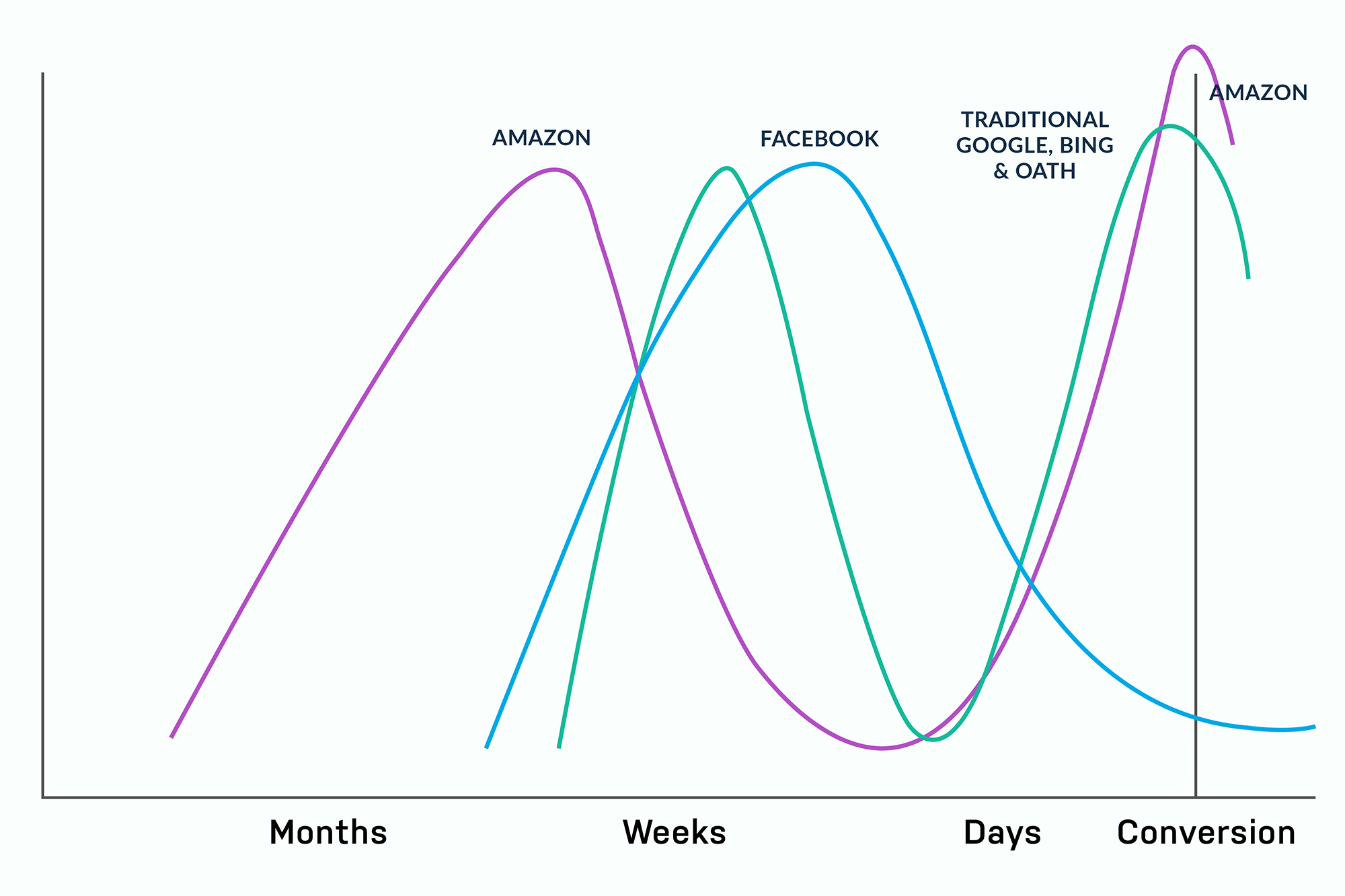Ads on Amazon are native – fit in naturally with the content and information present on the pages where they appear – and are intent driven, making them very effective. From a simple product search, for example, an ad appears that looks exactly like a regular product listing – unobtrusive, native, and engaging for the shopper.
These native ecommerce ads have higher conversion rates than banners or contextual ads on other sites. Which is why brands are increasingly investing in them, especially on Amazon.
Today’s online purchase journey, however, is increasingly non-linear, with people hopping between traditional search engines, ecommerce sites such as Amazon, and Facebook, Pinterest and the other social networks as they twist and turn through many phases: inspiration, product discovery, focused product research and comparison, and active online shopping.

Visualisation of a typical path to purchase
The chart above shows how consumers use Amazon, Facebook and traditional search engines on their journey – seeing audience-targeted Facebook posts, search ads, display ads on Amazon and other exposure related content. As the customer moves toward the conversion to the right of the chart, the shopping phase, they are exposed to keyword targeted, final purchase ads on Google, Amazon, Bing etc.
So if you are an ecommerce advertiser who has invested in maximizing your, keyword-targeted native ads programme, how do you begin to build an integrated strategy to enrich that program? It makes sense to want to find ways to combine and sync an Amazon marketing strategy with search and social campaigns, for example.
Such additional investment in the Amazon purchase path can help expand the audience for your brand’s products and reach customers at multiple points in their purchase journey in order to drive more conversions.
Things are evolving rapidly in this area. Here are a couple of practical things you can do now to get started.
Optimise spend holistically across all publishers
As new commerce budgets start coming in to performance advertising, you need a holistic approach to understand your customer engagement strategy in order to help you find the most effective channel for these investments.
Depending on where in the customer journey your target customers are, you may choose to place these new budgets directly on Amazon search advertising as well as evaluating other channels. It is important to analyse how certain keywords are performing on Amazon as well as on Google and Bing, for example.
At Kenshoo, we have seen clients optimising spend on specific phrases or terms based on CPCs or conversion rates from different channels and publishers. You need to keep tabs on performance and optimise the budget as a whole.
And ideally, in order to move quickly on opportunities you need to have access to up-to-date performance data from the various publishers – and to ensure the teams that are managing them (if they’re separate) are working together.
It’s not just the traditional search engines you should be looking at of course. Pinterest is an increasingly important destination, where consumers go for inspiration and ideas. In fact, in a study of consumer journeys related to buying Halloween costumes, searches for related terms peaked on Pinterest in mid-September – nearly six weeks ahead of the holiday itself.
So as an Amazon advertiser – especially if you sell products based on visual appeal – you should also be considering allocating performance advertising budget to Pinterest using broader head terms to help you prospect for customers who are in the product discovery and research phase.
Use Facebook ads to attract traffic and conversions on Amazon
eMarketer recently published research suggesting 42% of consumers who discover brands on Facebook are likely to go on and complete their purchases on Amazon. This is actually a higher proportion than those who decide to complete the transaction on the brands’ own websites (36%).
The truth is that brands are already aware that a lot of traffic to their Amazon product detail pages comes from Facebook. They may not have been able to track it, but they know there is value there and it is having an impact. And they have a huge appetite to capitalise on this.
Many brands are starting to take up the opportunity to use Amazon Stores for this purpose. What is an Amazon Store? It’s a landing page on Amazon that is dedicated to your products and brand – ultimately your own custom brand destination with a custom URL on Amazon. The landing page will have your brand’s look and feel and showcase as many products from your company as you like. Importantly, no competitors can advertise within the confines of your store which makes it an ideal landing page if you want to drive traffic from Amazon Marketing Services ads as well from external sources such as Facebook.
You can use part of your ecommerce marketing spend on Facebook ads such Dynamic Product Ads to promote specific products or product groups and drive visitors to your Amazon Stores page. And you can monitor performance, tracking metrics such as daily visitors, page views, and attributed sales.
Ecommerce advertising on Amazon is becoming an important part of the digital marketing ecosystem. And if you are already advertising on Amazon, you should be looking for ways to maximise its effectiveness by integrating it into your overall digital marketing strategy and tactics.
More on Amazon:

Comments